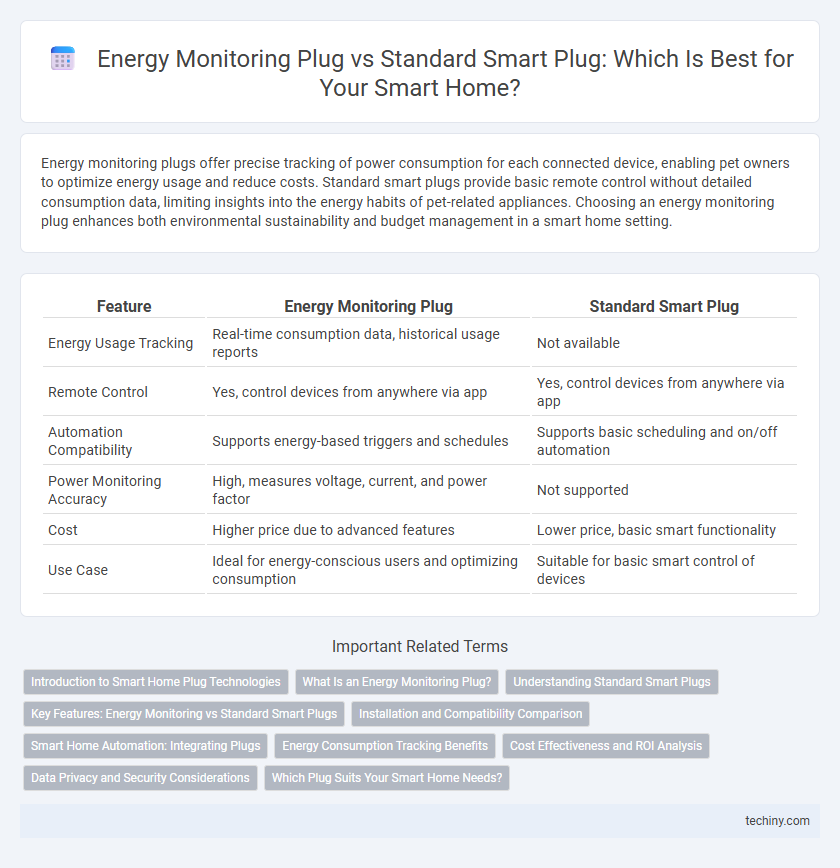Energy monitoring plugs offer precise tracking of power consumption for each connected device, enabling pet owners to optimize energy usage and reduce costs. Standard smart plugs provide basic remote control without detailed consumption data, limiting insights into the energy habits of pet-related appliances. Choosing an energy monitoring plug enhances both environmental sustainability and budget management in a smart home setting.
Table of Comparison
| Feature | Energy Monitoring Plug | Standard Smart Plug |
|---|---|---|
| Energy Usage Tracking | Real-time consumption data, historical usage reports | Not available |
| Remote Control | Yes, control devices from anywhere via app | Yes, control devices from anywhere via app |
| Automation Compatibility | Supports energy-based triggers and schedules | Supports basic scheduling and on/off automation |
| Power Monitoring Accuracy | High, measures voltage, current, and power factor | Not supported |
| Cost | Higher price due to advanced features | Lower price, basic smart functionality |
| Use Case | Ideal for energy-conscious users and optimizing consumption | Suitable for basic smart control of devices |
Introduction to Smart Home Plug Technologies
Energy monitoring plugs offer real-time tracking of power consumption, enabling users to optimize energy usage and reduce costs, while standard smart plugs primarily provide remote on/off control and basic scheduling features. Smart home plug technologies integrate with platforms like Alexa, Google Home, and Apple HomeKit, supporting automation and voice commands to enhance convenience. Advanced energy monitoring plugs include features such as historical usage reports, customizable alerts, and compatibility with energy management systems for comprehensive smart home energy solutions.
What Is an Energy Monitoring Plug?
An Energy Monitoring Plug is a smart device designed to track and report real-time electricity consumption of connected appliances, enabling better management of energy use. Unlike standard smart plugs, which primarily provide remote control and scheduling functions, energy monitoring plugs offer detailed insights into power usage, helping reduce energy bills and promote eco-friendly habits. These plugs often integrate with smart home systems and apps to deliver comprehensive analytics and alerts on energy consumption patterns.
Understanding Standard Smart Plugs
Standard smart plugs enable remote control and scheduling of connected devices via smartphone apps or voice assistants but lack advanced energy usage tracking features. Unlike energy monitoring plugs, they do not provide real-time consumption data or detailed reports on power usage patterns. This limits their ability to optimize energy efficiency or identify high-energy appliances within a smart home system.
Key Features: Energy Monitoring vs Standard Smart Plugs
Energy monitoring plugs provide real-time data on electricity usage, enabling users to track energy consumption and identify high-usage devices, which standard smart plugs typically lack. These advanced plugs offer detailed insights, including voltage, current, and power metrics, facilitating more efficient energy management and cost savings. Standard smart plugs primarily focus on remote control and scheduling functions without integrating comprehensive energy monitoring capabilities.
Installation and Compatibility Comparison
Energy monitoring plugs offer straightforward installation similar to standard smart plugs, requiring simple insertion into existing outlets without professional assistance. Compatibility with major smart home platforms like Amazon Alexa, Google Home, and Apple HomeKit remains consistent across both plug types, though energy monitoring plugs provide enhanced functionality by tracking real-time power usage and historical consumption data. Standard smart plugs focus primarily on remote on/off control, whereas energy monitoring plugs integrate advanced features that support energy management and efficiency optimization within smart home ecosystems.
Smart Home Automation: Integrating Plugs
Energy monitoring plugs provide precise real-time data on power consumption, enabling smarter energy management within smart home automation systems. These plugs integrate seamlessly with home hubs to optimize appliance schedules and reduce electricity costs, unlike standard smart plugs that only offer remote on/off control. Incorporating energy monitoring plugs enhances overall system efficiency by delivering actionable insights for more informed automation decisions.
Energy Consumption Tracking Benefits
Energy monitoring plugs provide real-time data on electricity usage, enabling precise tracking of energy consumption for individual devices compared to standard smart plugs that only offer remote control features. These devices help identify energy-hungry appliances, promoting cost savings and enhancing overall energy efficiency in smart homes. Integrating energy monitoring plugs with home automation systems supports informed decision-making and sustainable energy management.
Cost Effectiveness and ROI Analysis
Energy monitoring plugs provide detailed real-time data on power consumption, enabling users to identify energy waste and optimize usage, which significantly enhances cost-effectiveness compared to standard smart plugs that only offer basic on/off control. The ROI analysis shows that energy monitoring plugs can lead to substantial savings on electricity bills over time, often recouping the initial investment faster through improved energy management. Investing in an energy monitoring plug not only reduces monthly utility expenses but also supports long-term sustainability goals by promoting efficient energy use.
Data Privacy and Security Considerations
Energy monitoring plugs often incorporate advanced encryption protocols and secure data storage to protect sensitive consumption data, whereas standard smart plugs may lack robust privacy features, increasing the risk of unauthorized access. By transmitting granular energy usage information, energy monitoring plugs require stringent cybersecurity measures to prevent potential exploitation and ensure user confidentiality. Users prioritizing data privacy should choose energy monitoring plugs that comply with industry standards like GDPR and employ end-to-end encryption over basic smart plugs without dedicated security mechanisms.
Which Plug Suits Your Smart Home Needs?
Energy monitoring plugs provide real-time electricity usage data, enabling you to track and optimize power consumption for improved energy efficiency. Standard smart plugs offer basic remote control and scheduling but lack detailed energy insights, making them suitable for users prioritizing convenience over analytics. Choosing between the two depends on whether you value comprehensive energy management or straightforward device automation in your smart home setup.
Energy Monitoring Plug vs Standard Smart Plug Infographic

 techiny.com
techiny.com